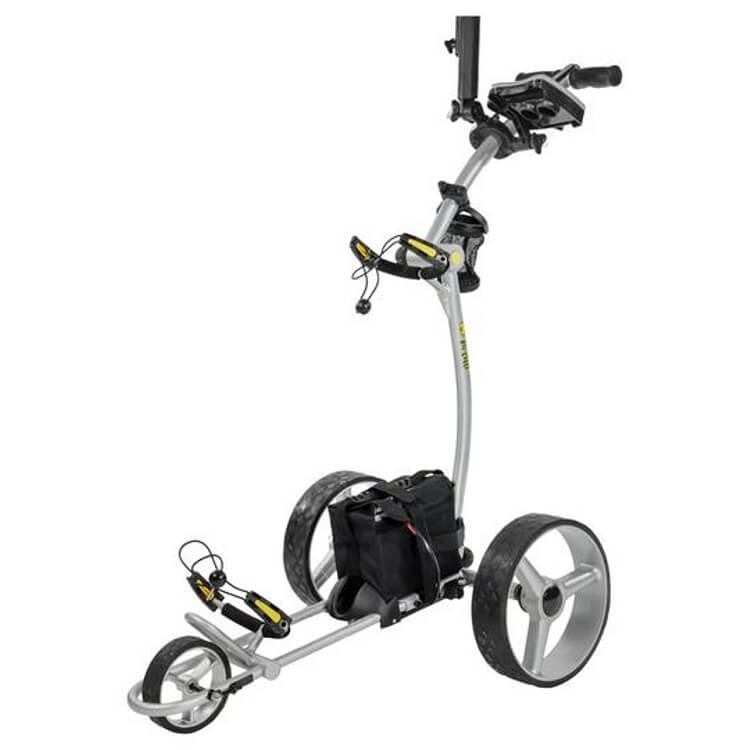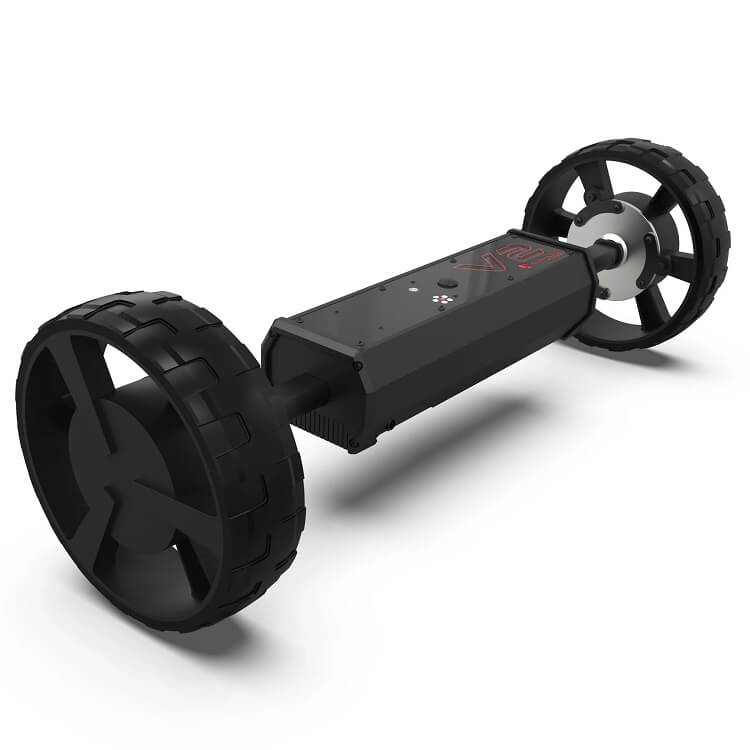Best electric golf push carts for effortless fairway glide

The best way to experience most golf courses is by walking them. Walking slows down the pace of your game, helps you focus, and can improve your scores. Plus, it’s the healthier route. Walking a golf course is equivalent to 5 miles, but as we get older or play a particularly hilly course, carrying our own golf bags or even pushing our own cart can be hard, sapping energy for the next shot. Electric push carts, sometimes called trolleys, are a great alternative when you still want to take the walk but want to ease the strain. It’s almost like having a caddie but without any of the awkward small talk.
Top 5 electric golf push carts
Staff favorite: Motocaddy M7 Remote
Best budget: BatCaddy X4 Sport
Best DIY hack: Alphard Golf Club Booster V2 Cart
Best follow cart: Stewart Golf Q Follow
Best for hilly courses: MGI Zip Navigator
How we chose the best electric golf push carts
We researched manufacturer specifications, including battery life, maneuverability, and carts that use remote control, to create a shortlist of the top five electric golf push carts (or trolleys) to help you navigate your golf course. Then, we combed detailed product descriptions, ratings, and reviews to find the best trolley for each category.
Staff favorite: Motocaddy M7 Remote
Staff favorite: Motocaddy M7 Remote
Benefits
— Extra back wheel prevents tipping over
— Remote control
— Automatic downhill control
Drawbacks
— Doesn’t have a follow mode
The Motocaddy M7 Remote is the premier trolly for its bevy of features and stability control. The trolley’s remote control is responsive and intuitive, allowing you to steer the cart in any direction. There are nine speed settings, and the automatic downhill control enables the cart to maintain its speed setting.
There’s also a pause and resume feature as well as an emergency stop to keep the golfer in control. Additionally, the M7 allows you to lock the handset so it’s not accidentally engaged. The kickback wheel ensures the cart won’t tip over, and after 18 holes, this cart is ready to roll for another 18, giving it excellent battery life for its many features.
Number of wheels: 4 | Battery life: 36 holes | Remote: Yes | Weight: 31.7 lbs. | Warranty: 2 years
Best budget: Batcaddy X4 Sport
Best budget: Batcaddy X4 Sport
Benefits
— 9 forward speeds
— Cruise control
— Auto-timed distance control
Drawbacks
— Lithium batteries are an upcharge
The Batcaddy X4 Sport is a great choice that comes at roughly half the price of other brands in this category — even if you choose to pay extra for the upgraded lithium battery. Despite its lower cost, the trolley has admirable features, such as cruise control with speed recall and auto-timed distance control, which allows you to set the trolley to travel 10, 20, or 30 yards.
The top speed of the trolley is 7 mph, and you can easily use one hand to control the unit and steer. For avid players, the company recommends upgrading to “The Pro” lithium battery, which costs $300. That upcharge still saves you about $500 compared to our top choice. The single motor X4 will last up to 72 holes when “The Pro” battery is fully charged, one of the longest run times we found. And if you forget to charge the unit, it can still be used as a traditional push cart.
Number of wheels: 3 | Battery life: 36 holes on entry-level battery, 72 holes on upgraded Pro battery | Remote: No | Weight: 20 lbs. (trolley) | Warranty: 2 years (trolley), 1 year (standard lithium battery)
Best DIY hack: Alphard Club Booster V2
Best DIY hack: Alphard Club Booster V2
Benefits
— Motorizes your existing push cart
— Smart tether enables follow mode
— Made from aircraft-grade aluminum
Drawbacks
— Stability depends on push cart model
The Club Booster V2 is an ingenious solution where the unit will replace your cart’s back wheels and axle with Club Booster’s dual-motor waterproof unit and polycarbonate wheels. Using a six-way internal gyroscope, the unit can maintain a straight course either with the included remote control or by tethering yourself to the cart on a clip, where the unit will then read your direction and speed to keep a consistent pace.
The Club Booster V2 has an electronic braking system that keeps it parked on inclines and an auto-distance feature allowing you to send it to the next tee box while you putt. The company includes instructions and specific axles for eight popular push cart models. After your round, simply unclick your cart from the unit, fold it up, and store it easily in the trunk.
Number of wheels: 2 + your existing cart’s front wheel(s) | Battery life: 27 holes | Remote: Yes | Weight: 21 lbs. | Warranty: 2 years (trolley), 1 year (battery and charger)
Best follow cart: Stewart Golf Q Follow
Best follow cart: Stewart Golf Q Follow
Benefits
— Excellent follow mode
— Tight-turning radius
— Compact folding design
Drawbacks
— High price tag
Stewart is considered the leader in follow carts, which can cost nearly double our top pick with the upgraded 36-hole battery option. Yet, the technology here is compelling as the unit will maintain a 6-foot distance behind you in follow mode. Simply press a button on the remote control and clip it to your back pocket, and the trolley will follow you.
Additionally, the Q Follow is one of the most maneuverable carts, meaning you don’t have to alter your path on the course. For tight spots, though, it can easily switch to manual model, and you can push it. The trolley has a retractable “stabilizer” on the rear axle with two ball-bearing wheels attached, allowing it to remain upright on uneven surfaces. With an app on your phone or watch and Bluetooth connectivity, you can monitor the battery life.
Number of wheels: 4 | Battery life: 18 holes, $200 upcharge for 36-hole battery | Remote: Yes | Weight: 33 lbs. (trolley) | Warranty: 2 years
Best for hilly courses: MGI Zip Navigator
Best for hilly courses: MGI Zip Navigator
Benefits
— Slim, compact design
— Tracks walking distance
— Easy to use remote
Drawbacks
— No follow mode
Zip Navigator is equipped with a set of all-terrain wheels and great maneuverability, making it ideal for hilly courses, despite its lack of follow mode. The trolley is powered by two 230-watt motors and comes standard with a battery lasting 36 holes.
Like other models, an internal gyroscope keeps the trolley on a straight path, even on hilly terrain, and will automatically adjust its speed going downhill. The front wheel is actually a dual-wheel swivel that allows it to turn nimbly and comfortably. The company is careful to point out that not all stand and carry bags will fit easily on the trolley’s chassis.
Number of wheels: 4 | Battery life: 36 holes | Remote: Yes | Weight: 28.6 lbs. (trolley) | Warranty: 3 years
Wrap-up
The best trolleys feature advanced technology that allows you to walk the course as if you were using a caddy. We picked models at various price points with various technological features to suit a wide range of needs. Electric trolleys are best for those looking for more than just saving their back on the course. If pushing a cart isn’t a problem, an electrified trolley is probably unnecessary and will save you a lot of money.
How to pick the right cart for you
Budget and where you play golf the most are two factors to consider, as flatter surfaces may not require the more expensive models in our roundup. You should also consider whether or not you want a remote control, which would most likely be a decision made in concert with the terrain of your course. A flat course may allow you to simply walk close enough to the trolley without fear of losing control of it.
Price
The cheapest trolley we reviewed started at $700. Our most expensive model was around the $2,900 mark. That’s a wide vacillation in price, but factors that contribute to cost include the single or dual-motors on the wheels, battery life, remote control inclusion, and follow mode availability. Internal gyroscopes and even GPS enhancement — with yardages provided while playing — all contribute to the price of a model as well.
Stability
If possible, ensure your bag will securely fit on the trolley and work at your course. Some companies offer risk-free trials, and we encourage using that. Whichever trolley you use may work well with a different golf bag than your current one, which can also affect the unit’s stability. Don’t be afraid to experiment with some combinations if you’re willing to commit financially to the electric trolley.
Battery life
Lithium batteries, just like the ones in your phone, run down over time. Each manufacturer has built its trolley with high-grade materials, but battery life for your round (and for the long term) requires investigation. Many players report carrying an extra battery during their rounds just to be safe. Still, take into account how many motors the battery will run, the terrain the trolley will traverse, and the weight it’ll carry.
Some trolleys won’t allow you to push or disengage them from the battery, meaning if you’re out of juice, you can’t push them the rest of the way. Each manufacturer has strong warranties on the actual unit, with battery warranties varying over time. Keep in mind that many companies charge extra for batteries that run longer than 18 holes.
Maneuverability
The best carts have a front wheel that rotates 360 degrees. Fixed wheels on the front can sometimes struggle over certain terrains or when making tight turns. Carts with follow features are designed to stay close to you, which could cause problems, so be sure they also have remote controls. That way, you can determine the path they travel, which is helpful if you want to send it on to the next hole.
FAQ
How much do replacement or extra batteries cost?
Battery costs vary from manufacturer, but a good rule of thumb is that they cost $200 at minimum.
How much does a good electric golf cart cost?
Electric golf carts are an expensive item, but for older players, the average price point of $1,500 may be worth it when you consider how much easier walking the golf course becomes. Electric golf carts help you avoid the strain of pushing a cart up a hill or holding it from racing away from you once you crest that hill.
Are electric golf carts worth it?
Electric golf carts are worth it if you’ve reached a point where traditional push carts are sapping your strength and making it hard to finish an 18-hole round. If that’s the case, then consider an electric cart. Many older players say electric push carts have changed their game, allowing them to play 36 holes in a day when barely finishing 18 was the norm before their purchase.
Are electric push carts allowed on every course?
Check with your local course to ensure they are. Typically, the course’s rules regarding electric courses will follow that of a traditional push cart policy, but given that many of these units weigh more, double-check and be cognizant about the added weight on and around greens.






